Financial Management Report: Concepts, Statements, and Importance
VerifiedAdded on 2022/12/27
|12
|3076
|34
Report
AI Summary
This report delves into the core concepts of financial management, emphasizing its planning, organization, and control aspects within an organization. It highlights the importance of financial management in achieving business goals, including financial planning, resource allocation, investment opportunities, and financial stability. The report then explores the main financial statements: balance sheets, income statements, and cash flow statements, detailing their components and uses. It also covers the uses of financial ratios for analysis. The report provides a comprehensive understanding of financial management principles and their practical application in business operations. The report emphasizes the role of financial management in ensuring the efficient operation of a business.

3005
Paraphrase This Document
Need a fresh take? Get an instant paraphrase of this document with our AI Paraphraser
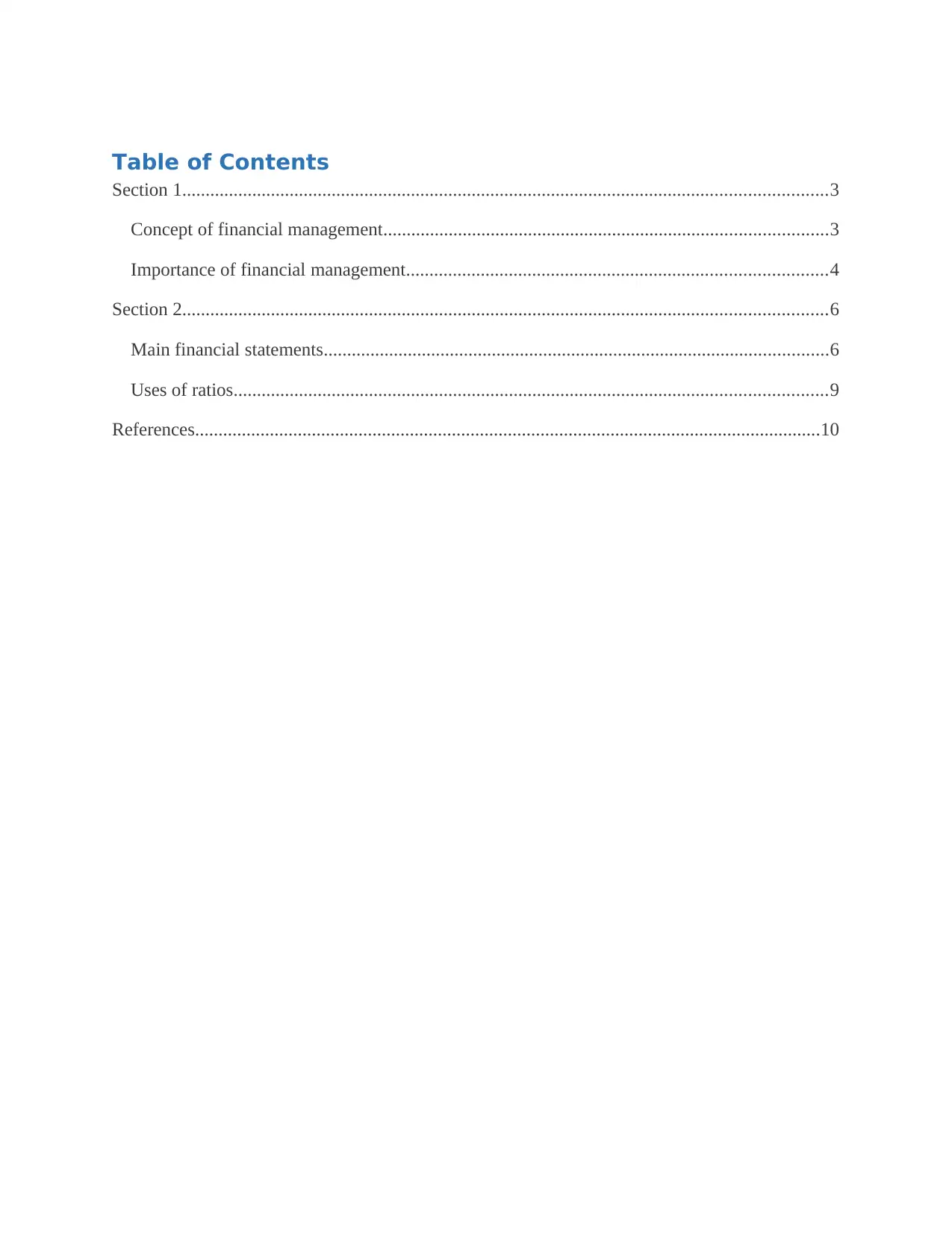
Table of Contents
Section 1..........................................................................................................................................3
Concept of financial management...............................................................................................3
Importance of financial management..........................................................................................4
Section 2..........................................................................................................................................6
Main financial statements............................................................................................................6
Uses of ratios...............................................................................................................................9
References......................................................................................................................................10
Section 1..........................................................................................................................................3
Concept of financial management...............................................................................................3
Importance of financial management..........................................................................................4
Section 2..........................................................................................................................................6
Main financial statements............................................................................................................6
Uses of ratios...............................................................................................................................9
References......................................................................................................................................10
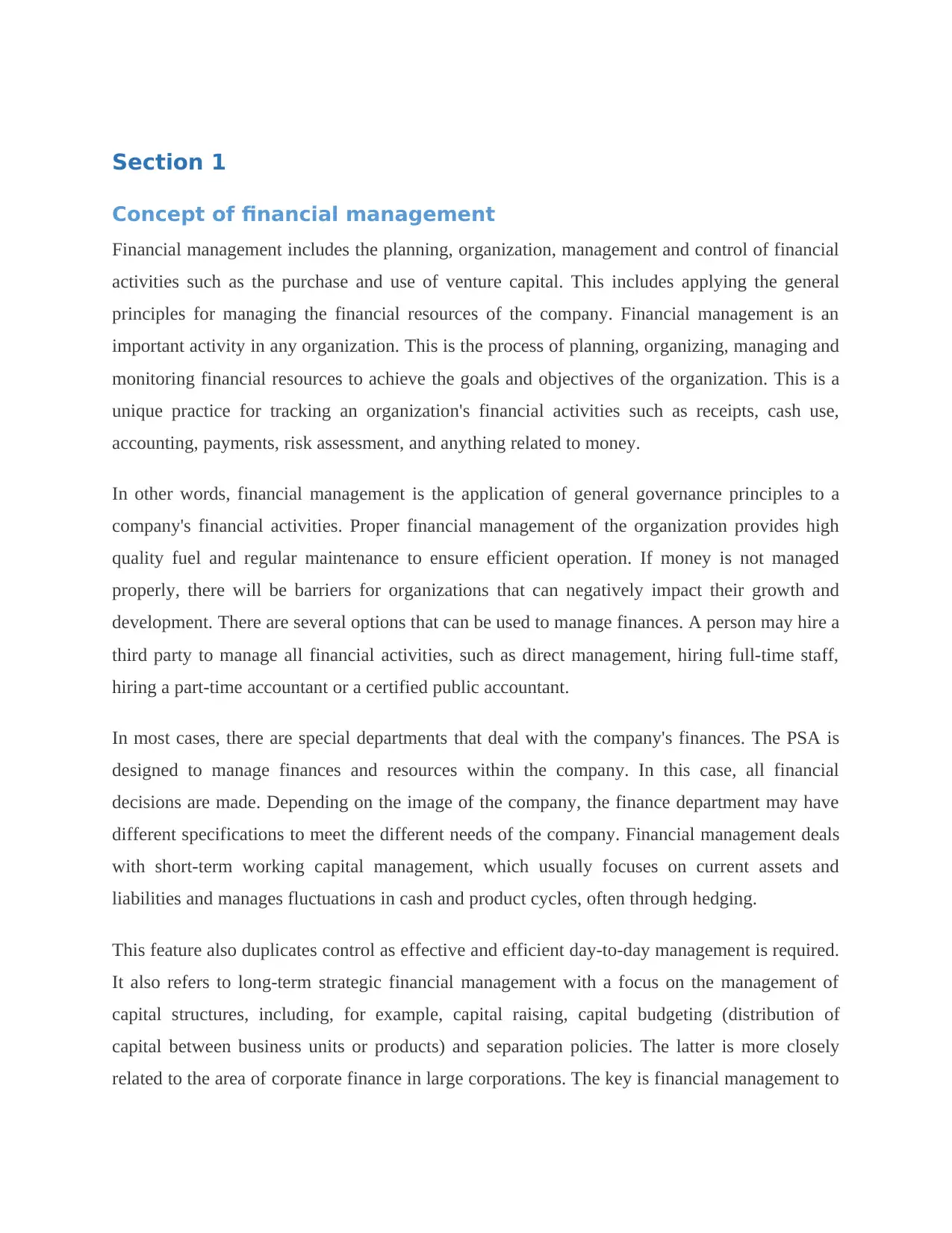
Section 1
Concept of financial management
Financial management includes the planning, organization, management and control of financial
activities such as the purchase and use of venture capital. This includes applying the general
principles for managing the financial resources of the company. Financial management is an
important activity in any organization. This is the process of planning, organizing, managing and
monitoring financial resources to achieve the goals and objectives of the organization. This is a
unique practice for tracking an organization's financial activities such as receipts, cash use,
accounting, payments, risk assessment, and anything related to money.
In other words, financial management is the application of general governance principles to a
company's financial activities. Proper financial management of the organization provides high
quality fuel and regular maintenance to ensure efficient operation. If money is not managed
properly, there will be barriers for organizations that can negatively impact their growth and
development. There are several options that can be used to manage finances. A person may hire a
third party to manage all financial activities, such as direct management, hiring full-time staff,
hiring a part-time accountant or a certified public accountant.
In most cases, there are special departments that deal with the company's finances. The PSA is
designed to manage finances and resources within the company. In this case, all financial
decisions are made. Depending on the image of the company, the finance department may have
different specifications to meet the different needs of the company. Financial management deals
with short-term working capital management, which usually focuses on current assets and
liabilities and manages fluctuations in cash and product cycles, often through hedging.
This feature also duplicates control as effective and efficient day-to-day management is required.
It also refers to long-term strategic financial management with a focus on the management of
capital structures, including, for example, capital raising, capital budgeting (distribution of
capital between business units or products) and separation policies. The latter is more closely
related to the area of corporate finance in large corporations. The key is financial management to
Concept of financial management
Financial management includes the planning, organization, management and control of financial
activities such as the purchase and use of venture capital. This includes applying the general
principles for managing the financial resources of the company. Financial management is an
important activity in any organization. This is the process of planning, organizing, managing and
monitoring financial resources to achieve the goals and objectives of the organization. This is a
unique practice for tracking an organization's financial activities such as receipts, cash use,
accounting, payments, risk assessment, and anything related to money.
In other words, financial management is the application of general governance principles to a
company's financial activities. Proper financial management of the organization provides high
quality fuel and regular maintenance to ensure efficient operation. If money is not managed
properly, there will be barriers for organizations that can negatively impact their growth and
development. There are several options that can be used to manage finances. A person may hire a
third party to manage all financial activities, such as direct management, hiring full-time staff,
hiring a part-time accountant or a certified public accountant.
In most cases, there are special departments that deal with the company's finances. The PSA is
designed to manage finances and resources within the company. In this case, all financial
decisions are made. Depending on the image of the company, the finance department may have
different specifications to meet the different needs of the company. Financial management deals
with short-term working capital management, which usually focuses on current assets and
liabilities and manages fluctuations in cash and product cycles, often through hedging.
This feature also duplicates control as effective and efficient day-to-day management is required.
It also refers to long-term strategic financial management with a focus on the management of
capital structures, including, for example, capital raising, capital budgeting (distribution of
capital between business units or products) and separation policies. The latter is more closely
related to the area of corporate finance in large corporations. The key is financial management to
⊘ This is a preview!⊘
Do you want full access?
Subscribe today to unlock all pages.

Trusted by 1+ million students worldwide
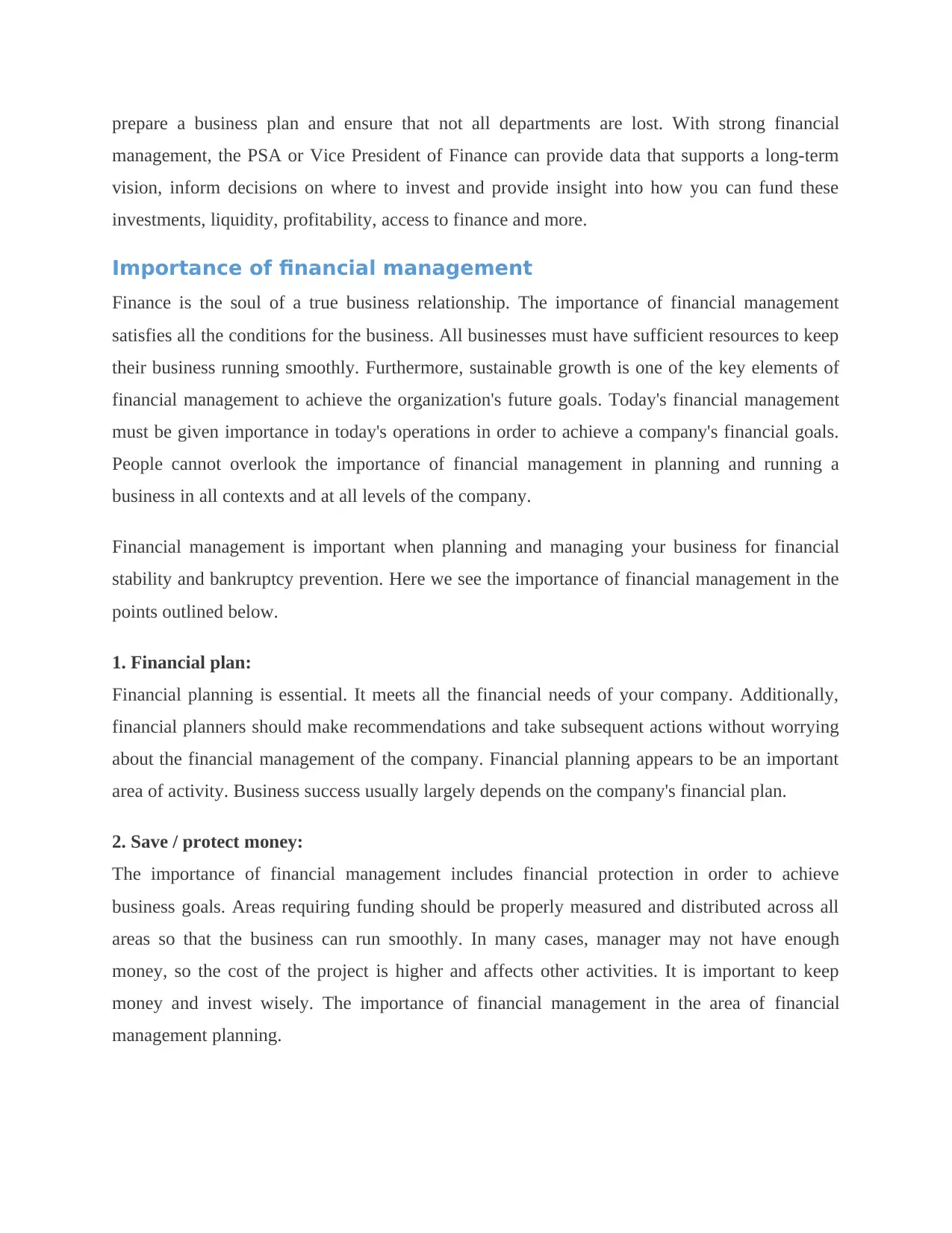
prepare a business plan and ensure that not all departments are lost. With strong financial
management, the PSA or Vice President of Finance can provide data that supports a long-term
vision, inform decisions on where to invest and provide insight into how you can fund these
investments, liquidity, profitability, access to finance and more.
Importance of financial management
Finance is the soul of a true business relationship. The importance of financial management
satisfies all the conditions for the business. All businesses must have sufficient resources to keep
their business running smoothly. Furthermore, sustainable growth is one of the key elements of
financial management to achieve the organization's future goals. Today's financial management
must be given importance in today's operations in order to achieve a company's financial goals.
People cannot overlook the importance of financial management in planning and running a
business in all contexts and at all levels of the company.
Financial management is important when planning and managing your business for financial
stability and bankruptcy prevention. Here we see the importance of financial management in the
points outlined below.
1. Financial plan:
Financial planning is essential. It meets all the financial needs of your company. Additionally,
financial planners should make recommendations and take subsequent actions without worrying
about the financial management of the company. Financial planning appears to be an important
area of activity. Business success usually largely depends on the company's financial plan.
2. Save / protect money:
The importance of financial management includes financial protection in order to achieve
business goals. Areas requiring funding should be properly measured and distributed across all
areas so that the business can run smoothly. In many cases, manager may not have enough
money, so the cost of the project is higher and affects other activities. It is important to keep
money and invest wisely. The importance of financial management in the area of financial
management planning.
management, the PSA or Vice President of Finance can provide data that supports a long-term
vision, inform decisions on where to invest and provide insight into how you can fund these
investments, liquidity, profitability, access to finance and more.
Importance of financial management
Finance is the soul of a true business relationship. The importance of financial management
satisfies all the conditions for the business. All businesses must have sufficient resources to keep
their business running smoothly. Furthermore, sustainable growth is one of the key elements of
financial management to achieve the organization's future goals. Today's financial management
must be given importance in today's operations in order to achieve a company's financial goals.
People cannot overlook the importance of financial management in planning and running a
business in all contexts and at all levels of the company.
Financial management is important when planning and managing your business for financial
stability and bankruptcy prevention. Here we see the importance of financial management in the
points outlined below.
1. Financial plan:
Financial planning is essential. It meets all the financial needs of your company. Additionally,
financial planners should make recommendations and take subsequent actions without worrying
about the financial management of the company. Financial planning appears to be an important
area of activity. Business success usually largely depends on the company's financial plan.
2. Save / protect money:
The importance of financial management includes financial protection in order to achieve
business goals. Areas requiring funding should be properly measured and distributed across all
areas so that the business can run smoothly. In many cases, manager may not have enough
money, so the cost of the project is higher and affects other activities. It is important to keep
money and invest wisely. The importance of financial management in the area of financial
management planning.
Paraphrase This Document
Need a fresh take? Get an instant paraphrase of this document with our AI Paraphraser
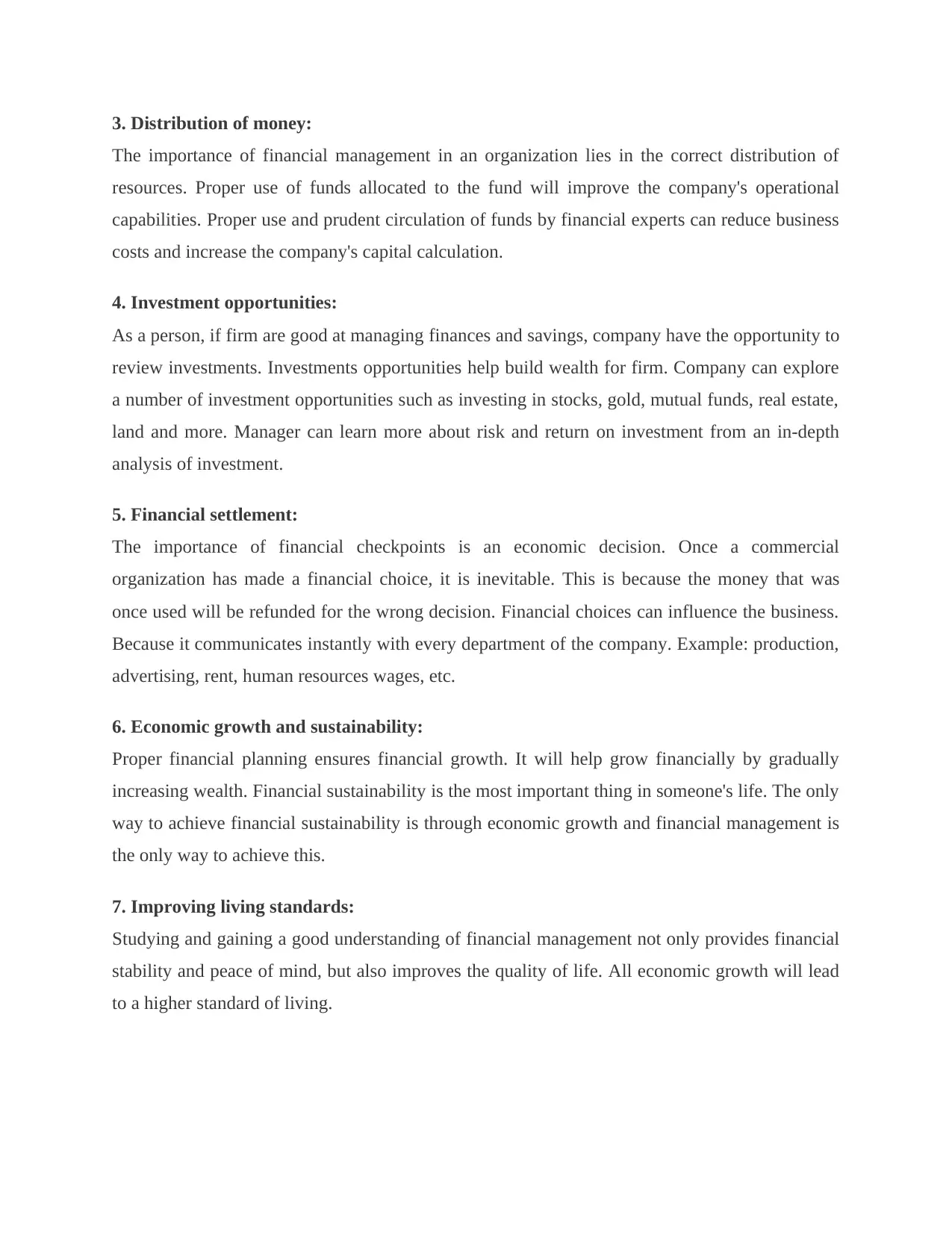
3. Distribution of money:
The importance of financial management in an organization lies in the correct distribution of
resources. Proper use of funds allocated to the fund will improve the company's operational
capabilities. Proper use and prudent circulation of funds by financial experts can reduce business
costs and increase the company's capital calculation.
4. Investment opportunities:
As a person, if firm are good at managing finances and savings, company have the opportunity to
review investments. Investments opportunities help build wealth for firm. Company can explore
a number of investment opportunities such as investing in stocks, gold, mutual funds, real estate,
land and more. Manager can learn more about risk and return on investment from an in-depth
analysis of investment.
5. Financial settlement:
The importance of financial checkpoints is an economic decision. Once a commercial
organization has made a financial choice, it is inevitable. This is because the money that was
once used will be refunded for the wrong decision. Financial choices can influence the business.
Because it communicates instantly with every department of the company. Example: production,
advertising, rent, human resources wages, etc.
6. Economic growth and sustainability:
Proper financial planning ensures financial growth. It will help grow financially by gradually
increasing wealth. Financial sustainability is the most important thing in someone's life. The only
way to achieve financial sustainability is through economic growth and financial management is
the only way to achieve this.
7. Improving living standards:
Studying and gaining a good understanding of financial management not only provides financial
stability and peace of mind, but also improves the quality of life. All economic growth will lead
to a higher standard of living.
The importance of financial management in an organization lies in the correct distribution of
resources. Proper use of funds allocated to the fund will improve the company's operational
capabilities. Proper use and prudent circulation of funds by financial experts can reduce business
costs and increase the company's capital calculation.
4. Investment opportunities:
As a person, if firm are good at managing finances and savings, company have the opportunity to
review investments. Investments opportunities help build wealth for firm. Company can explore
a number of investment opportunities such as investing in stocks, gold, mutual funds, real estate,
land and more. Manager can learn more about risk and return on investment from an in-depth
analysis of investment.
5. Financial settlement:
The importance of financial checkpoints is an economic decision. Once a commercial
organization has made a financial choice, it is inevitable. This is because the money that was
once used will be refunded for the wrong decision. Financial choices can influence the business.
Because it communicates instantly with every department of the company. Example: production,
advertising, rent, human resources wages, etc.
6. Economic growth and sustainability:
Proper financial planning ensures financial growth. It will help grow financially by gradually
increasing wealth. Financial sustainability is the most important thing in someone's life. The only
way to achieve financial sustainability is through economic growth and financial management is
the only way to achieve this.
7. Improving living standards:
Studying and gaining a good understanding of financial management not only provides financial
stability and peace of mind, but also improves the quality of life. All economic growth will lead
to a higher standard of living.
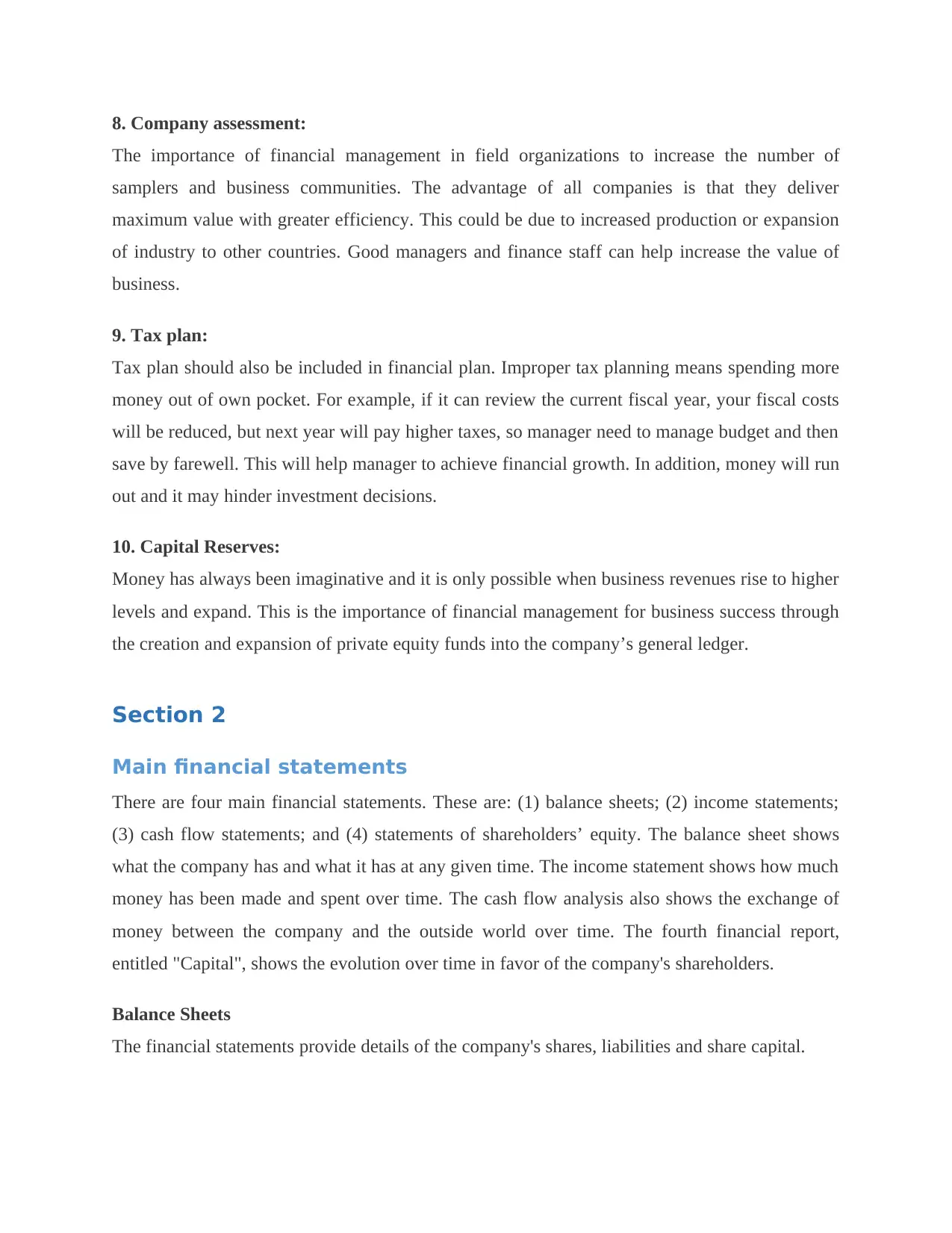
8. Company assessment:
The importance of financial management in field organizations to increase the number of
samplers and business communities. The advantage of all companies is that they deliver
maximum value with greater efficiency. This could be due to increased production or expansion
of industry to other countries. Good managers and finance staff can help increase the value of
business.
9. Tax plan:
Tax plan should also be included in financial plan. Improper tax planning means spending more
money out of own pocket. For example, if it can review the current fiscal year, your fiscal costs
will be reduced, but next year will pay higher taxes, so manager need to manage budget and then
save by farewell. This will help manager to achieve financial growth. In addition, money will run
out and it may hinder investment decisions.
10. Capital Reserves:
Money has always been imaginative and it is only possible when business revenues rise to higher
levels and expand. This is the importance of financial management for business success through
the creation and expansion of private equity funds into the company’s general ledger.
Section 2
Main financial statements
There are four main financial statements. These are: (1) balance sheets; (2) income statements;
(3) cash flow statements; and (4) statements of shareholders’ equity. The balance sheet shows
what the company has and what it has at any given time. The income statement shows how much
money has been made and spent over time. The cash flow analysis also shows the exchange of
money between the company and the outside world over time. The fourth financial report,
entitled "Capital", shows the evolution over time in favor of the company's shareholders.
Balance Sheets
The financial statements provide details of the company's shares, liabilities and share capital.
The importance of financial management in field organizations to increase the number of
samplers and business communities. The advantage of all companies is that they deliver
maximum value with greater efficiency. This could be due to increased production or expansion
of industry to other countries. Good managers and finance staff can help increase the value of
business.
9. Tax plan:
Tax plan should also be included in financial plan. Improper tax planning means spending more
money out of own pocket. For example, if it can review the current fiscal year, your fiscal costs
will be reduced, but next year will pay higher taxes, so manager need to manage budget and then
save by farewell. This will help manager to achieve financial growth. In addition, money will run
out and it may hinder investment decisions.
10. Capital Reserves:
Money has always been imaginative and it is only possible when business revenues rise to higher
levels and expand. This is the importance of financial management for business success through
the creation and expansion of private equity funds into the company’s general ledger.
Section 2
Main financial statements
There are four main financial statements. These are: (1) balance sheets; (2) income statements;
(3) cash flow statements; and (4) statements of shareholders’ equity. The balance sheet shows
what the company has and what it has at any given time. The income statement shows how much
money has been made and spent over time. The cash flow analysis also shows the exchange of
money between the company and the outside world over time. The fourth financial report,
entitled "Capital", shows the evolution over time in favor of the company's shareholders.
Balance Sheets
The financial statements provide details of the company's shares, liabilities and share capital.
⊘ This is a preview!⊘
Do you want full access?
Subscribe today to unlock all pages.

Trusted by 1+ million students worldwide
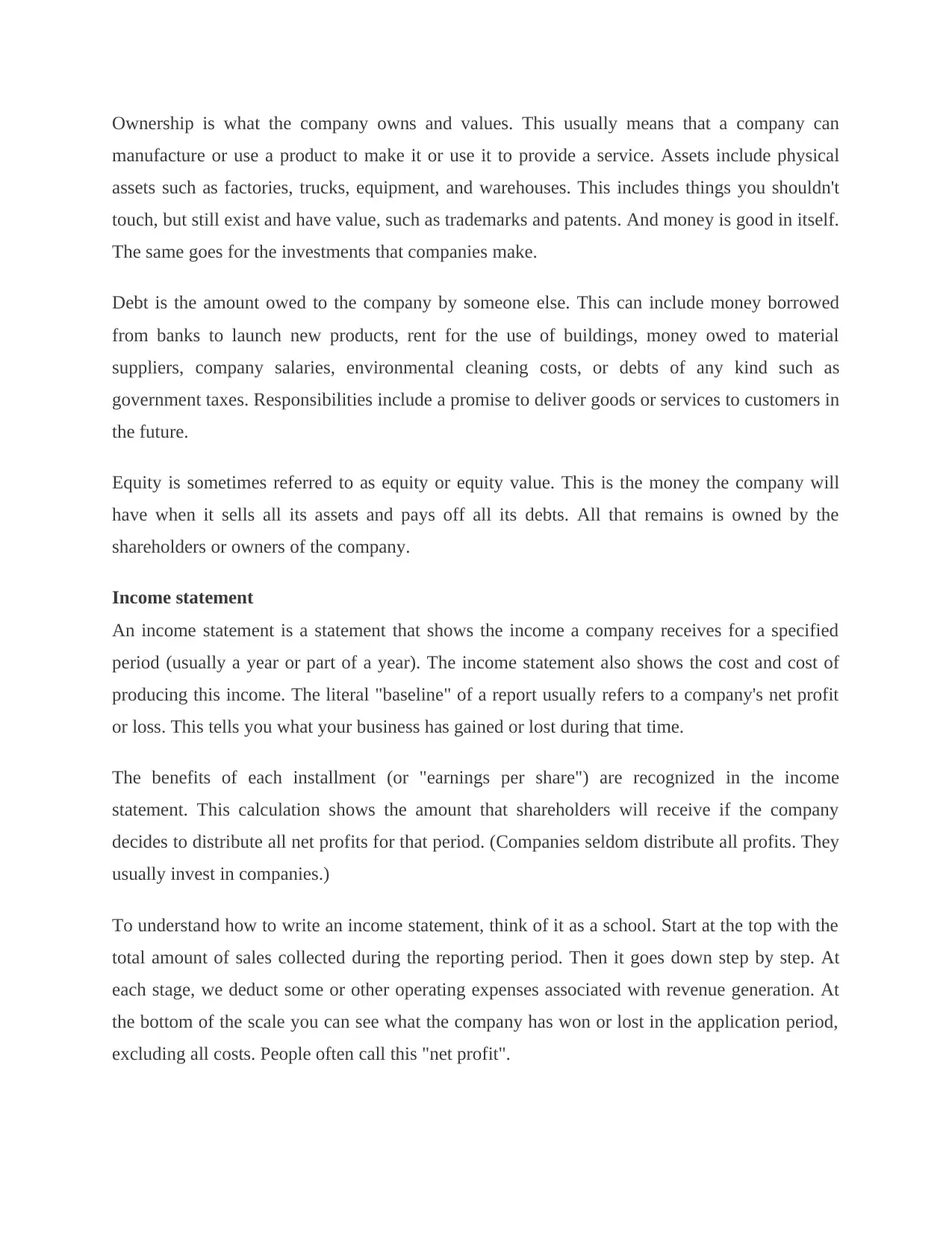
Ownership is what the company owns and values. This usually means that a company can
manufacture or use a product to make it or use it to provide a service. Assets include physical
assets such as factories, trucks, equipment, and warehouses. This includes things you shouldn't
touch, but still exist and have value, such as trademarks and patents. And money is good in itself.
The same goes for the investments that companies make.
Debt is the amount owed to the company by someone else. This can include money borrowed
from banks to launch new products, rent for the use of buildings, money owed to material
suppliers, company salaries, environmental cleaning costs, or debts of any kind such as
government taxes. Responsibilities include a promise to deliver goods or services to customers in
the future.
Equity is sometimes referred to as equity or equity value. This is the money the company will
have when it sells all its assets and pays off all its debts. All that remains is owned by the
shareholders or owners of the company.
Income statement
An income statement is a statement that shows the income a company receives for a specified
period (usually a year or part of a year). The income statement also shows the cost and cost of
producing this income. The literal "baseline" of a report usually refers to a company's net profit
or loss. This tells you what your business has gained or lost during that time.
The benefits of each installment (or "earnings per share") are recognized in the income
statement. This calculation shows the amount that shareholders will receive if the company
decides to distribute all net profits for that period. (Companies seldom distribute all profits. They
usually invest in companies.)
To understand how to write an income statement, think of it as a school. Start at the top with the
total amount of sales collected during the reporting period. Then it goes down step by step. At
each stage, we deduct some or other operating expenses associated with revenue generation. At
the bottom of the scale you can see what the company has won or lost in the application period,
excluding all costs. People often call this "net profit".
manufacture or use a product to make it or use it to provide a service. Assets include physical
assets such as factories, trucks, equipment, and warehouses. This includes things you shouldn't
touch, but still exist and have value, such as trademarks and patents. And money is good in itself.
The same goes for the investments that companies make.
Debt is the amount owed to the company by someone else. This can include money borrowed
from banks to launch new products, rent for the use of buildings, money owed to material
suppliers, company salaries, environmental cleaning costs, or debts of any kind such as
government taxes. Responsibilities include a promise to deliver goods or services to customers in
the future.
Equity is sometimes referred to as equity or equity value. This is the money the company will
have when it sells all its assets and pays off all its debts. All that remains is owned by the
shareholders or owners of the company.
Income statement
An income statement is a statement that shows the income a company receives for a specified
period (usually a year or part of a year). The income statement also shows the cost and cost of
producing this income. The literal "baseline" of a report usually refers to a company's net profit
or loss. This tells you what your business has gained or lost during that time.
The benefits of each installment (or "earnings per share") are recognized in the income
statement. This calculation shows the amount that shareholders will receive if the company
decides to distribute all net profits for that period. (Companies seldom distribute all profits. They
usually invest in companies.)
To understand how to write an income statement, think of it as a school. Start at the top with the
total amount of sales collected during the reporting period. Then it goes down step by step. At
each stage, we deduct some or other operating expenses associated with revenue generation. At
the bottom of the scale you can see what the company has won or lost in the application period,
excluding all costs. People often call this "net profit".
Paraphrase This Document
Need a fresh take? Get an instant paraphrase of this document with our AI Paraphraser
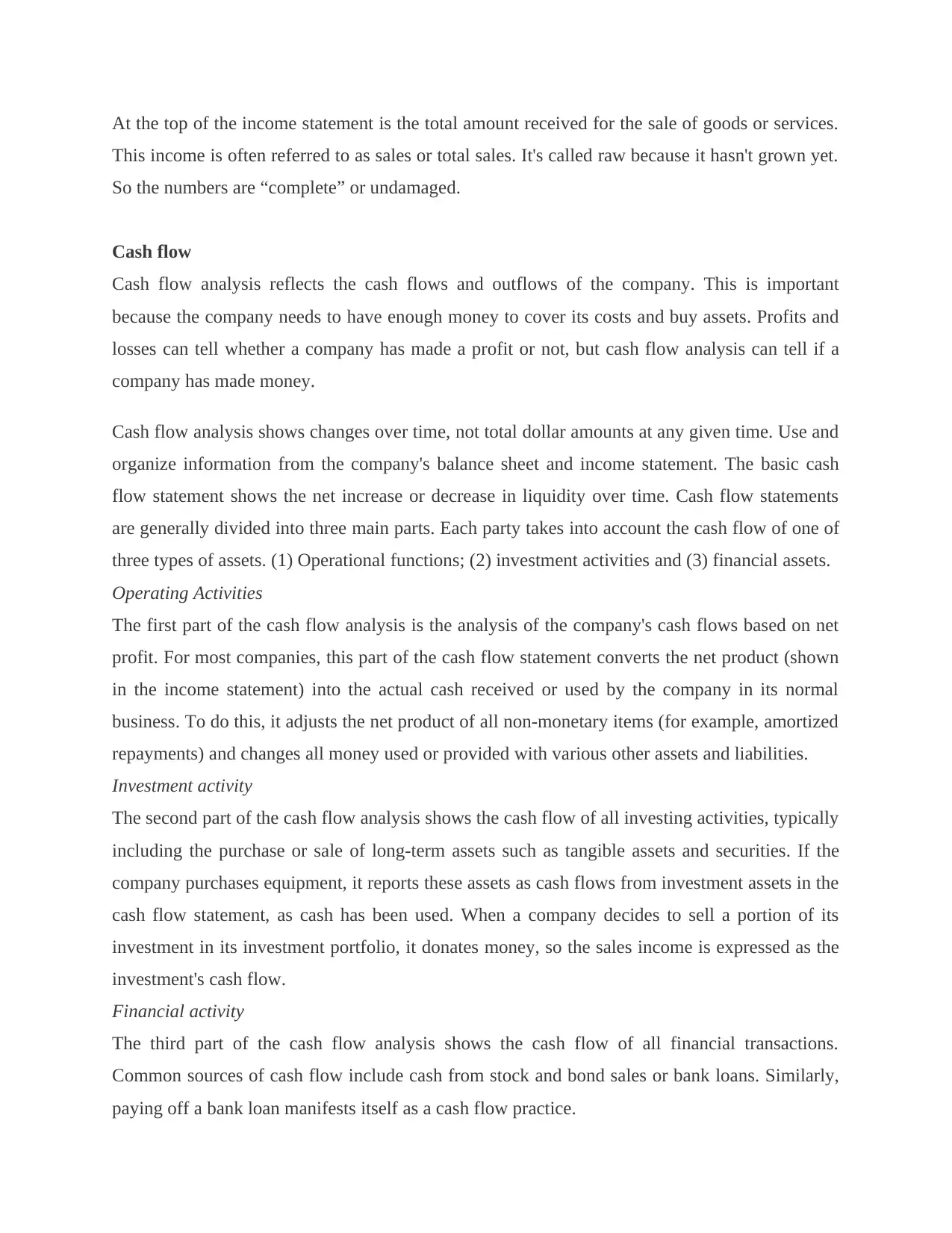
At the top of the income statement is the total amount received for the sale of goods or services.
This income is often referred to as sales or total sales. It's called raw because it hasn't grown yet.
So the numbers are “complete” or undamaged.
Cash flow
Cash flow analysis reflects the cash flows and outflows of the company. This is important
because the company needs to have enough money to cover its costs and buy assets. Profits and
losses can tell whether a company has made a profit or not, but cash flow analysis can tell if a
company has made money.
Cash flow analysis shows changes over time, not total dollar amounts at any given time. Use and
organize information from the company's balance sheet and income statement. The basic cash
flow statement shows the net increase or decrease in liquidity over time. Cash flow statements
are generally divided into three main parts. Each party takes into account the cash flow of one of
three types of assets. (1) Operational functions; (2) investment activities and (3) financial assets.
Operating Activities
The first part of the cash flow analysis is the analysis of the company's cash flows based on net
profit. For most companies, this part of the cash flow statement converts the net product (shown
in the income statement) into the actual cash received or used by the company in its normal
business. To do this, it adjusts the net product of all non-monetary items (for example, amortized
repayments) and changes all money used or provided with various other assets and liabilities.
Investment activity
The second part of the cash flow analysis shows the cash flow of all investing activities, typically
including the purchase or sale of long-term assets such as tangible assets and securities. If the
company purchases equipment, it reports these assets as cash flows from investment assets in the
cash flow statement, as cash has been used. When a company decides to sell a portion of its
investment in its investment portfolio, it donates money, so the sales income is expressed as the
investment's cash flow.
Financial activity
The third part of the cash flow analysis shows the cash flow of all financial transactions.
Common sources of cash flow include cash from stock and bond sales or bank loans. Similarly,
paying off a bank loan manifests itself as a cash flow practice.
This income is often referred to as sales or total sales. It's called raw because it hasn't grown yet.
So the numbers are “complete” or undamaged.
Cash flow
Cash flow analysis reflects the cash flows and outflows of the company. This is important
because the company needs to have enough money to cover its costs and buy assets. Profits and
losses can tell whether a company has made a profit or not, but cash flow analysis can tell if a
company has made money.
Cash flow analysis shows changes over time, not total dollar amounts at any given time. Use and
organize information from the company's balance sheet and income statement. The basic cash
flow statement shows the net increase or decrease in liquidity over time. Cash flow statements
are generally divided into three main parts. Each party takes into account the cash flow of one of
three types of assets. (1) Operational functions; (2) investment activities and (3) financial assets.
Operating Activities
The first part of the cash flow analysis is the analysis of the company's cash flows based on net
profit. For most companies, this part of the cash flow statement converts the net product (shown
in the income statement) into the actual cash received or used by the company in its normal
business. To do this, it adjusts the net product of all non-monetary items (for example, amortized
repayments) and changes all money used or provided with various other assets and liabilities.
Investment activity
The second part of the cash flow analysis shows the cash flow of all investing activities, typically
including the purchase or sale of long-term assets such as tangible assets and securities. If the
company purchases equipment, it reports these assets as cash flows from investment assets in the
cash flow statement, as cash has been used. When a company decides to sell a portion of its
investment in its investment portfolio, it donates money, so the sales income is expressed as the
investment's cash flow.
Financial activity
The third part of the cash flow analysis shows the cash flow of all financial transactions.
Common sources of cash flow include cash from stock and bond sales or bank loans. Similarly,
paying off a bank loan manifests itself as a cash flow practice.
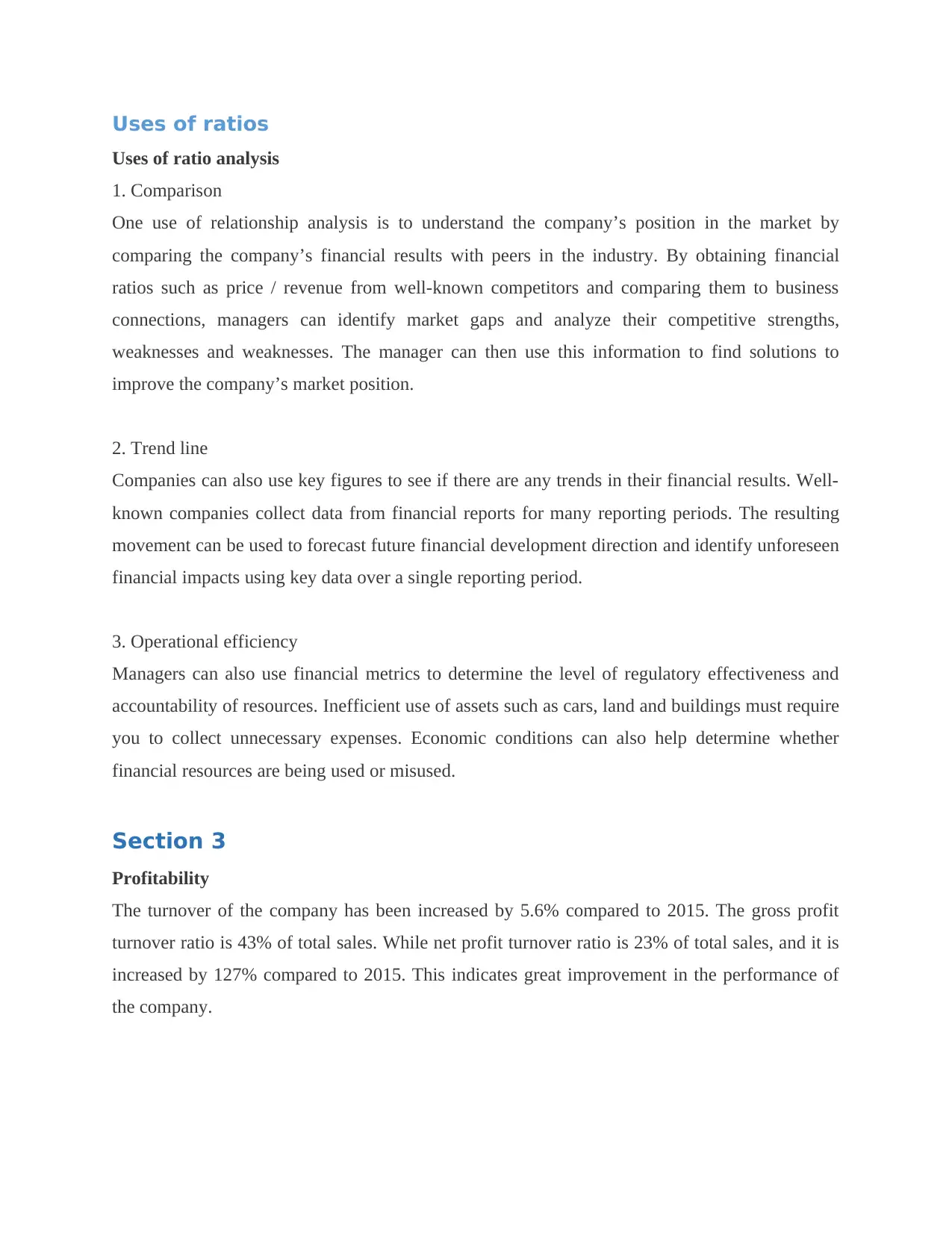
Uses of ratios
Uses of ratio analysis
1. Comparison
One use of relationship analysis is to understand the company’s position in the market by
comparing the company’s financial results with peers in the industry. By obtaining financial
ratios such as price / revenue from well-known competitors and comparing them to business
connections, managers can identify market gaps and analyze their competitive strengths,
weaknesses and weaknesses. The manager can then use this information to find solutions to
improve the company’s market position.
2. Trend line
Companies can also use key figures to see if there are any trends in their financial results. Well-
known companies collect data from financial reports for many reporting periods. The resulting
movement can be used to forecast future financial development direction and identify unforeseen
financial impacts using key data over a single reporting period.
3. Operational efficiency
Managers can also use financial metrics to determine the level of regulatory effectiveness and
accountability of resources. Inefficient use of assets such as cars, land and buildings must require
you to collect unnecessary expenses. Economic conditions can also help determine whether
financial resources are being used or misused.
Section 3
Profitability
The turnover of the company has been increased by 5.6% compared to 2015. The gross profit
turnover ratio is 43% of total sales. While net profit turnover ratio is 23% of total sales, and it is
increased by 127% compared to 2015. This indicates great improvement in the performance of
the company.
Uses of ratio analysis
1. Comparison
One use of relationship analysis is to understand the company’s position in the market by
comparing the company’s financial results with peers in the industry. By obtaining financial
ratios such as price / revenue from well-known competitors and comparing them to business
connections, managers can identify market gaps and analyze their competitive strengths,
weaknesses and weaknesses. The manager can then use this information to find solutions to
improve the company’s market position.
2. Trend line
Companies can also use key figures to see if there are any trends in their financial results. Well-
known companies collect data from financial reports for many reporting periods. The resulting
movement can be used to forecast future financial development direction and identify unforeseen
financial impacts using key data over a single reporting period.
3. Operational efficiency
Managers can also use financial metrics to determine the level of regulatory effectiveness and
accountability of resources. Inefficient use of assets such as cars, land and buildings must require
you to collect unnecessary expenses. Economic conditions can also help determine whether
financial resources are being used or misused.
Section 3
Profitability
The turnover of the company has been increased by 5.6% compared to 2015. The gross profit
turnover ratio is 43% of total sales. While net profit turnover ratio is 23% of total sales, and it is
increased by 127% compared to 2015. This indicates great improvement in the performance of
the company.
⊘ This is a preview!⊘
Do you want full access?
Subscribe today to unlock all pages.

Trusted by 1+ million students worldwide
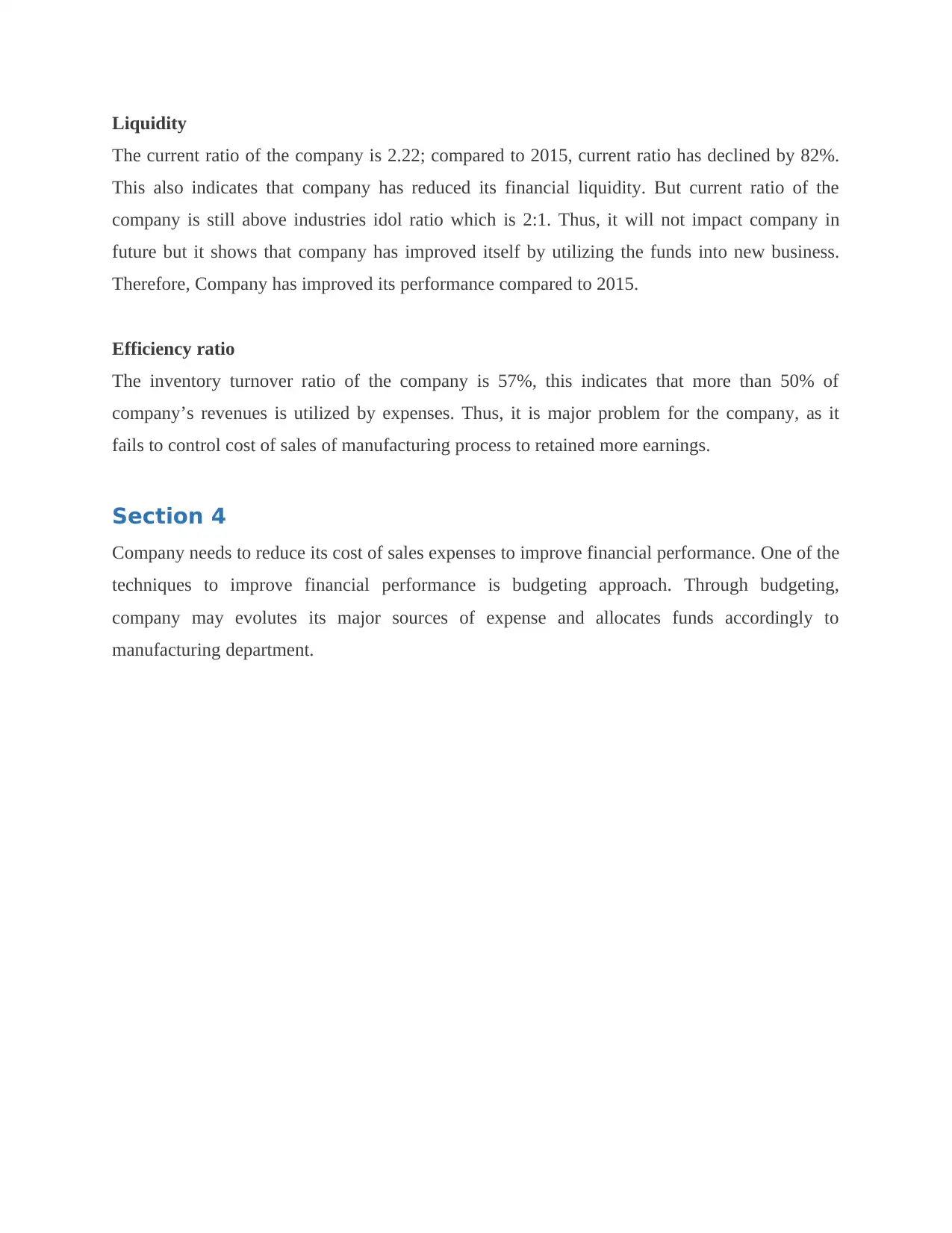
Liquidity
The current ratio of the company is 2.22; compared to 2015, current ratio has declined by 82%.
This also indicates that company has reduced its financial liquidity. But current ratio of the
company is still above industries idol ratio which is 2:1. Thus, it will not impact company in
future but it shows that company has improved itself by utilizing the funds into new business.
Therefore, Company has improved its performance compared to 2015.
Efficiency ratio
The inventory turnover ratio of the company is 57%, this indicates that more than 50% of
company’s revenues is utilized by expenses. Thus, it is major problem for the company, as it
fails to control cost of sales of manufacturing process to retained more earnings.
Section 4
Company needs to reduce its cost of sales expenses to improve financial performance. One of the
techniques to improve financial performance is budgeting approach. Through budgeting,
company may evolutes its major sources of expense and allocates funds accordingly to
manufacturing department.
The current ratio of the company is 2.22; compared to 2015, current ratio has declined by 82%.
This also indicates that company has reduced its financial liquidity. But current ratio of the
company is still above industries idol ratio which is 2:1. Thus, it will not impact company in
future but it shows that company has improved itself by utilizing the funds into new business.
Therefore, Company has improved its performance compared to 2015.
Efficiency ratio
The inventory turnover ratio of the company is 57%, this indicates that more than 50% of
company’s revenues is utilized by expenses. Thus, it is major problem for the company, as it
fails to control cost of sales of manufacturing process to retained more earnings.
Section 4
Company needs to reduce its cost of sales expenses to improve financial performance. One of the
techniques to improve financial performance is budgeting approach. Through budgeting,
company may evolutes its major sources of expense and allocates funds accordingly to
manufacturing department.
Paraphrase This Document
Need a fresh take? Get an instant paraphrase of this document with our AI Paraphraser
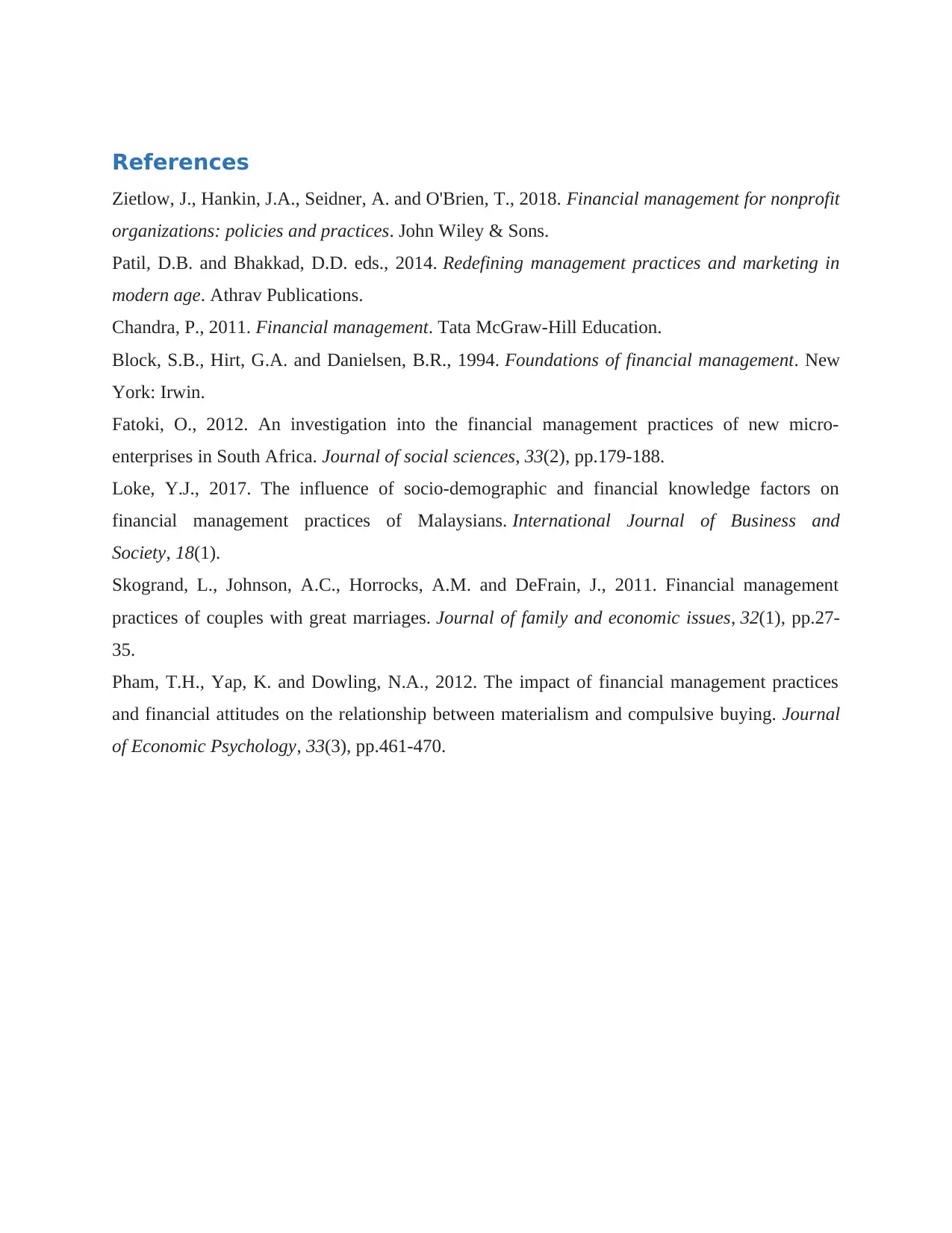
References
Zietlow, J., Hankin, J.A., Seidner, A. and O'Brien, T., 2018. Financial management for nonprofit
organizations: policies and practices. John Wiley & Sons.
Patil, D.B. and Bhakkad, D.D. eds., 2014. Redefining management practices and marketing in
modern age. Athrav Publications.
Chandra, P., 2011. Financial management. Tata McGraw-Hill Education.
Block, S.B., Hirt, G.A. and Danielsen, B.R., 1994. Foundations of financial management. New
York: Irwin.
Fatoki, O., 2012. An investigation into the financial management practices of new micro-
enterprises in South Africa. Journal of social sciences, 33(2), pp.179-188.
Loke, Y.J., 2017. The influence of socio-demographic and financial knowledge factors on
financial management practices of Malaysians. International Journal of Business and
Society, 18(1).
Skogrand, L., Johnson, A.C., Horrocks, A.M. and DeFrain, J., 2011. Financial management
practices of couples with great marriages. Journal of family and economic issues, 32(1), pp.27-
35.
Pham, T.H., Yap, K. and Dowling, N.A., 2012. The impact of financial management practices
and financial attitudes on the relationship between materialism and compulsive buying. Journal
of Economic Psychology, 33(3), pp.461-470.
Zietlow, J., Hankin, J.A., Seidner, A. and O'Brien, T., 2018. Financial management for nonprofit
organizations: policies and practices. John Wiley & Sons.
Patil, D.B. and Bhakkad, D.D. eds., 2014. Redefining management practices and marketing in
modern age. Athrav Publications.
Chandra, P., 2011. Financial management. Tata McGraw-Hill Education.
Block, S.B., Hirt, G.A. and Danielsen, B.R., 1994. Foundations of financial management. New
York: Irwin.
Fatoki, O., 2012. An investigation into the financial management practices of new micro-
enterprises in South Africa. Journal of social sciences, 33(2), pp.179-188.
Loke, Y.J., 2017. The influence of socio-demographic and financial knowledge factors on
financial management practices of Malaysians. International Journal of Business and
Society, 18(1).
Skogrand, L., Johnson, A.C., Horrocks, A.M. and DeFrain, J., 2011. Financial management
practices of couples with great marriages. Journal of family and economic issues, 32(1), pp.27-
35.
Pham, T.H., Yap, K. and Dowling, N.A., 2012. The impact of financial management practices
and financial attitudes on the relationship between materialism and compulsive buying. Journal
of Economic Psychology, 33(3), pp.461-470.
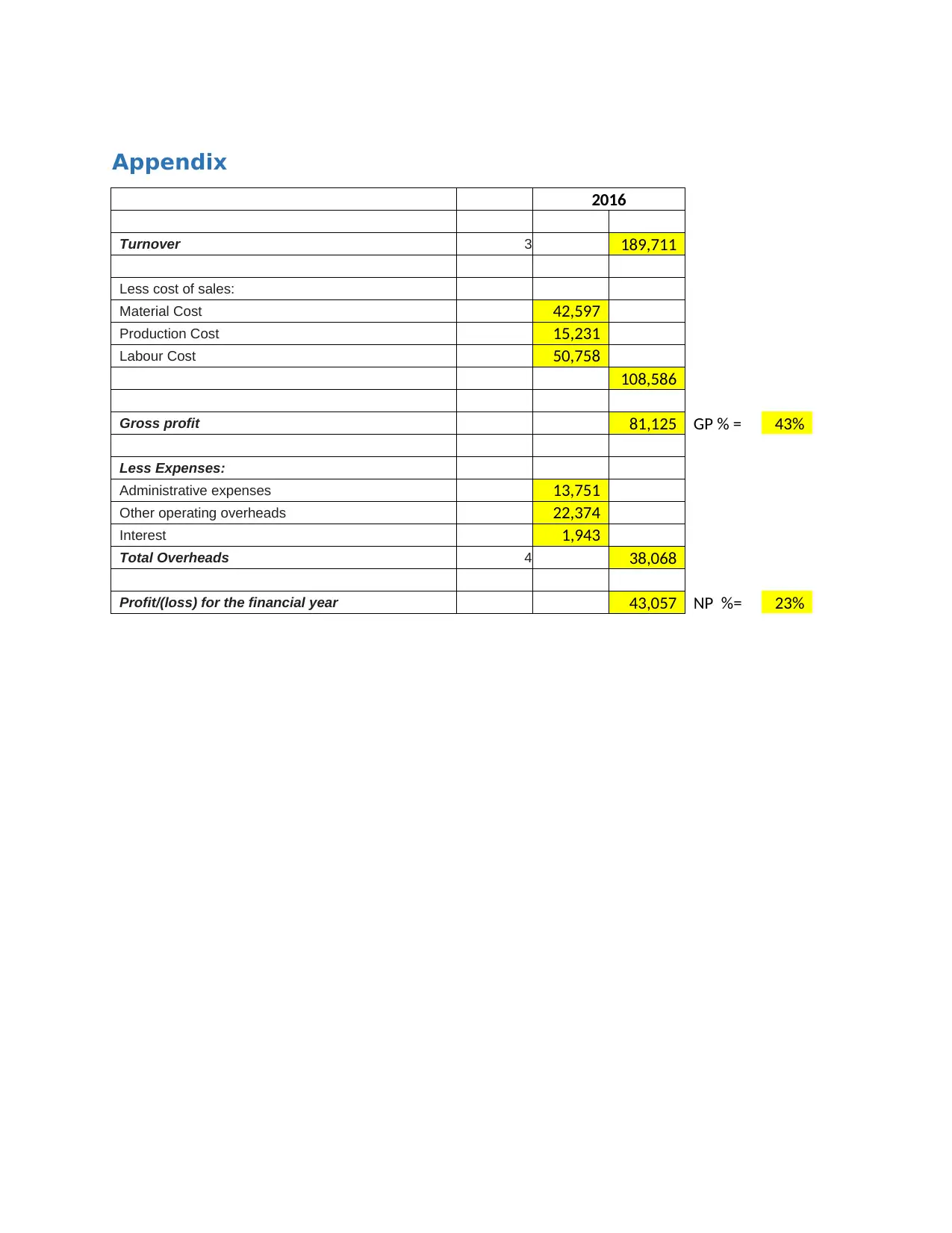
Appendix
2016
Turnover 3 189,711
Less cost of sales:
Material Cost 42,597
Production Cost 15,231
Labour Cost 50,758
108,586
Gross profit 81,125 GP % = 43%
Less Expenses:
Administrative expenses 13,751
Other operating overheads 22,374
Interest 1,943
Total Overheads 4 38,068
Profit/(loss) for the financial year 43,057 NP %= 23%
2016
Turnover 3 189,711
Less cost of sales:
Material Cost 42,597
Production Cost 15,231
Labour Cost 50,758
108,586
Gross profit 81,125 GP % = 43%
Less Expenses:
Administrative expenses 13,751
Other operating overheads 22,374
Interest 1,943
Total Overheads 4 38,068
Profit/(loss) for the financial year 43,057 NP %= 23%
⊘ This is a preview!⊘
Do you want full access?
Subscribe today to unlock all pages.

Trusted by 1+ million students worldwide
1 out of 12
Related Documents
Your All-in-One AI-Powered Toolkit for Academic Success.
+13062052269
info@desklib.com
Available 24*7 on WhatsApp / Email
![[object Object]](/_next/static/media/star-bottom.7253800d.svg)
Unlock your academic potential
Copyright © 2020–2025 A2Z Services. All Rights Reserved. Developed and managed by ZUCOL.




